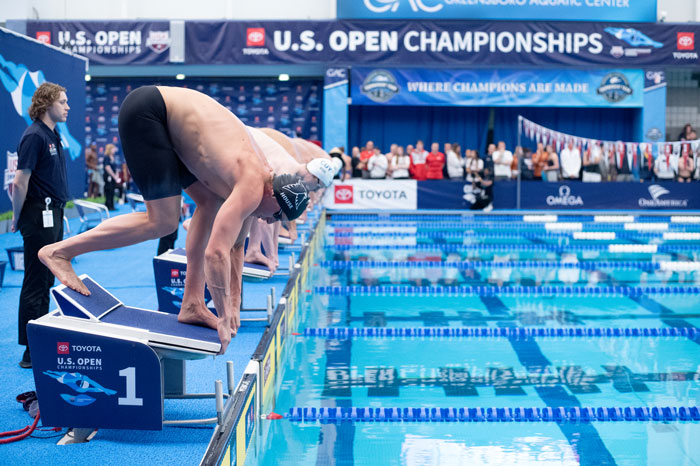In July of this year the summer Olympics will kick off in Paris, and a whole new crop of young people will be watching. And after the games are over, certain sports will see an uptick in interest, including swimming, as we always hear from learn-to-swim providers that enrollment increases after the Olympics.
And while competitive swimming is a great activity for young people, the sport is unlike jumping into a neighborhood baseball game or basketball scrimmage. Swim competitions involve much planning, coordination and execution to be successful. But it needn’t be daunting, you just need to do some homework, start well in advance and recruit others to help plan and organize.
A swim meet director is usually appointed by the meet host and is the coordinator of activities. Some responsibilities include securing a facility, obtaining a meet sanction, organizing committees, preparing meet invitations and distributing final results. It’s helpful to prepare a checklist for all tasks and even consult the notes of previous directors for suggestions.
You’ll likely need plenty of volunteers, which will often be parents of swimmers. Job duties will vary, including concession volunteers, timers, and clerk and course officials. These volunteers often will have little or no experience. Directors may want to offer training to convey governing body rules and get everyone up to speed.
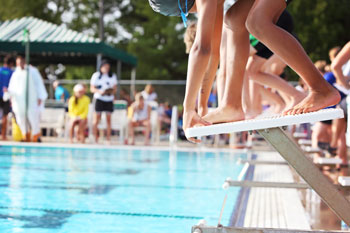
The St. Charles Swim Team (SCST) in St. Charles, Ill., is a competitive swim program for groups aged 5 to 14 and 14 and up. “The team is a member of USA Swimming and Illinois Swimming, and we compete locally, regionally and nationally throughout the year,” said Tim Lewarchick, St. Charles Aquatics executive director and SCST co-head coach.
When hosting meets, SCST utilizes many helpers, and Lewarchick shared a pre-meet email asking for volunteers. Jobs included: Announcer; Awards; Bull Pen Volunteers; Clean-up; Console (running time equipment and scoreboard); various Deck Helpers (including monitoring locker rooms); Heat Winners; Hospitality; Timing (one timer per lane); and Volunteer/Swimmer Check-in.
Securing a facility is obviously important. Organizations that form through YMCAs, schools or community programs likely have a pool of their own. For those looking to rent a pool, considerations include: pool size (having enough lanes for all planned events); warmup pool; spectator seating; quality locker room facilities; and a place for teams and swimmers to “hang out” between events.
Other commonly requested amenities include parking, a kitchen or cafeteria for officials and coaches, and a concession area. Plus areas for officials’ briefing, scoring and administrative tasks, staging, and awards and press, if applicable. Pools are often booked months ahead, so be aware. Written requests are helpful, spelling out the needed facilities and equipment, as is a meeting with a facility manager to make sure everyone is on the same page as far as expectations and requirements, including setup and cleanup.
SCST uses the pool facilities at the Norris Recreation Center, a community rec center operated by the St. Charles Park District. Lewarchick said the pool is kept at 81 degrees. “This seems to be a happy medium for the activities that we run: swim team, lessons, diving, water polo, lap and open swimming. Competition requires the pool to be 78 to 80 degrees. September through April, the pool is divided by bulkheads, which is two separate 25-yard pools. April through August we move the bulkheads down to the shallow end and then the pool becomes one 50-meter pool.”
Separate locker areas are available for men, women, adults and students/athletes, plus amenities for gender-neutral users and for those with handicaps. Permanent seating is available for 600 spectators, and “we have portable bleachers that the swimmers use, which seats around 450 swimmers,” said Lewarchick.
There’s a financial agreement with the park district on usage fees, and depending on the meet, admission can be charged. “Concessions and entry fees generate most of the revenue, and we also have vendors at the meet.” Vendors often pay a percentage of sales or a set fee.
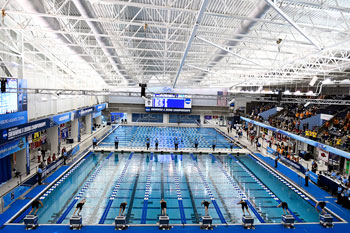
The Greensboro Aquatic Center (GAC) in North Carolina is one of the top aquatics facilities in the nation. And while they serve the Greensboro community with aquatic programming and recreation offerings, they also host numerous competitive meets, including high school and college events, USA Swimming and U.S. Masters meets, U.S. Water Polo events and myriad local, regional, national and international competitions.
There are four pools at GAC, according to David Hoover, manager and director of aquatics. “We use two pools for competitive meets and events—the Competition Pool and the Dive Well.”
The Training Pool and Recreation Pool serve different purposes, and each pool is maintained at a specific temperature to cater to its designated function. To enhance flexibility, the Competition Pool is equipped with two bulkheads, “allowing us to configure the pool in various ways based on the needs of specific meets,” said Hoover, who added that this accommodates a diverse range of aquatic events efficiently and effectively.
The GAC has permanent seating, accommodating 2,000 spectators. “Additionally, to cater to the varying needs of different events, we have seating for 800 on the pool deck, ensuring ample seating for athletes, coaches and additional spectators when necessary,” said Hoover.
Admission policies vary based on the event. “For collegiate and national-level events, there is typically an admission fee for spectators. However, for other events, the decision to charge admission rests with the meet host.”
Concessions are offered, generating extra revenue, and a comprehensive fee structure is tailored to accommodate various event sizes.
For competitions, athletes exclusively utilize the two locker room facilities designated for the Competition Pool, according to Hoover. “This approach aligns with Safe Sport rules and ensures a streamlined and secure environment for our participating athletes.”
Starting and timing systems and scoreboards/display systems are critical components at meets, and facilities need to explore their options, based on needs and budgets. Hoover said their timing system, encompassing block tops, pads and quantums (an intelligent timer), is the same system used at the Olympics. “The past few years have witnessed significant advancements in technology, and our choice reflects a strategic decision to embrace these innovations.” He added that they continually invest in state-of-the-art equipment, providing participants with the best possible competitive experience.
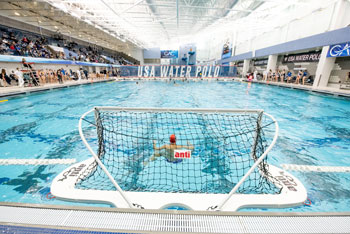
GAC also utilizes two state-of-the-art scoreboards that are specifically designed to meet the unique requirements of aquatic sports. “These versatile systems enable us to seamlessly display comprehensive information for a variety of sports, including swimming, diving, water polo and artistic swimming. The adaptability of our scoreboards ensures that we can provide an optimal viewing experience and deliver essential information for participants and spectators across different aquatic disciplines with video and playback components.”
Tina Wallen-Montalbano is director of marketing for a Loveland, Colo.-based company that manufactures timing and starting systems and scoreboards/video displays, including the system used by Lewarchick’s facility, which includes the timing system, starter, touch pads and scoreboard, and has the ability to run swimming, diving and water polo events. They offer two different start systems, one an entry-level starter, most commonly used for summer league and high school swim meets, and their newest elite version which is designed for larger facilities, according to Wallen-Montalbano.
She said the new system “also has new features such as alternate start tones, training mode with prerecorded ‘Take your marks’ and visual start sequencing to provide a level playing field amongst all swimmers, especially those who are deaf or hard of hearing.”
Wallen-Montalbano explained that their latest timing system allows facilities with their existing swim timing equipment to reap the benefits of using the new intuitive user interface. “(It) provides rich diagnostics, which allows you to check system set-up and health, allowing you to discover possible corroding connections throughout the timing system, and mitigate the effects of corrosion until the component can be repaired or replaced.”
Wallen-Montalbano said they offer scoreboards for all types of aquatics facilities, including standard LED numeric boards. And she said videoboards allow for much more than just aquatic timing and scoring. “Our videoboards can display facility messaging, advertisements, slide shows and live video. Our regional sales managers work with each facility to help determine the appropriate board size and pixel pitch to ensure that the facility is getting exactly what it needs.”
And what about some of the “simpler” equipment to consider? “In our experience hosting various competitions, we’ve identified several essential features that contribute to the seamless execution of events,” said Hoover. “Some key elements include ensuring an abundance of extra lane lines, diving boards, ample storage capacity, copy machines and any and all additional meet-related equipment. Our proactive approach involves having duplicates of critical equipment to address any unforeseen issues promptly.”
Lewarchick said “Lane lines, backstroke flags and starting blocks are all important to the competition pool. There are many types, and it becomes what the facility likes and can afford.”
Kristen Linehan Omli is vice president of a Columbus, Ohio-based company that manufactures lane lines, lane line storage reels, floats, pace clocks and backstroke flags. She explained that lane lines are a crucial part of competitive swimming, allowing swimmers to stay in their lane and dispersing waves so the swimmers don’t feel one another’s waves. “A lane line also has markers to let the swimmers and officials know where the correct markings are.” These come in four-inch and six-inch sizes.
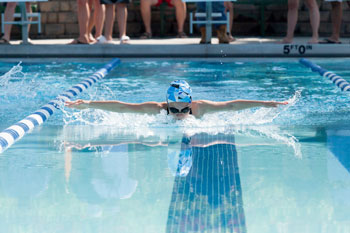
The lane lines are customizable, size and color alike. “We have a design tool on our website that will allow a customer to design their lane line and see what it looks like instantly,” said Omli.
There are two options for fastening the lane lines to the pool wall. “We have the take-up reel that requires a wrench to tighten the lane line—this has been on the market for over 50 years. We just came out with a new tensioner that doesn’t require a wrench.”
She added that storage reels are important, allowing a facility to take out their lane lines, clean the lanes and then store them. “Any facility that’s hosting meets has to be USA Swimming and NCAA compliant, and we’re proud partners of both.”
For swimmer times to be used as official times in an organization, a host must run their meet according to the rules of the governing body. For example, in the U.S., high school swim meets follow National Federation of State High School Associations (NFHS) rules. Some groups, including many summer leagues, don’t have a national governing body, though each still has rules a meet host needs to follow.
USA Swimming is the national governing body for the sport of swimming in the U.S., with more than 400,000 members and 3,100 clubs. It maintains the SWIMS database, the official collection place for swimmers’ times accepted by USA Swimming. Local Swim Committees (LSCs) are the regional governing bodies for USA Swimming. Meet directors and officials need to run swim meets according to the rules of the applicable governing organization.
“We regularly host site visits from various groups and governing bodies,” said Hoover. “And in hosting the diverse range of events, the GAC has to continuously adapt to adhere to the requirements set by these various governing bodies,” allowing the facility to “accommodate a wide array of events and competitions.”
Meet hosts are typically required to supply officials or referees, which are oftentimes parents or other volunteers. Hosts might find someone to act as a team liaison for your team officials and learn what it takes to become one to pass this information along. Encourage volunteers to pursue swim officiating certifications from USA Swimming. Ask other team coaches or leaders for recommendations. Sometimes local governing bodies will have a list of certified officials.
Swim meet timers are oftentimes supplied by hosts, and they’re typically volunteers too, recruited from family or even spectators. Some hosts recruit timers from high school clubs or other service organizations, but it’s important to provide them with clear instructions and the information they’ll need.
“The responsibility for supplying referees and the administrative team for events lies with the meet host,” said Hoover. “However, we take charge of providing essential personnel to ensure the smooth execution of meets. This includes supplying lifeguards, housekeeping staff, meet technician staff (responsible for operating the timing system), lifeguard supervisors and event managers. For national-level meets, we also coordinate the presence of EMTs or athletic trainers, reinforcing our commitment to ensuring a safe and well-managed environment for all participants and attendees.”
Lewarchick said “depending on the meet, there are certified officials, lifeguards and medical staff here at the meet.”
Indeed, safety is the top concern, and the meet director, referee, facility representative and others work together to identify potential risks and hazards, and make plans to prevent and respond to all safety issues.
Organizing a successful swim meet doesn’t have to be intimidating, just dive right in and you’ll find the rewards can be great. RM



